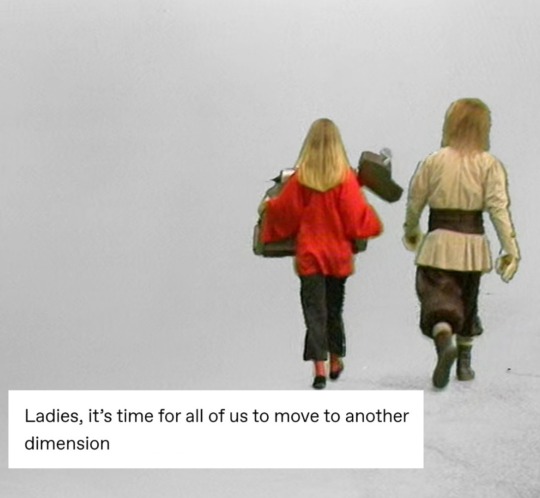#sarah franklin
Explore tagged Tumblr posts
Text








#pleease they are so cute#the nudge#cuties#cute things#love#aww#my heart#matlock#1x17#billy x sarah#sarah x billy#David Del Rio#Billy Martinez#Leah Lewis#Sarah Franklin
34 notes
·
View notes
Text
Happy news gays. There’s a WLW on a prime time CBS show AND she’s already a gay icon.
Check out Leah Lewis on Matlock!


#gay#wlw on tv#matlock#Leah Lewis#the half of it#sarah franklin#lesbian#I can’t find a gif of it yet but in the last episode#her work bestie says if there are any girls out there for her#and I was like#!!!!!!
29 notes
·
View notes
Text
Oh Sarah is such a disaster gay
13 notes
·
View notes
Text
Conclusion: Reevolution
Sarah Franklin
If the most common response to The Dialectic of Sex is a caricature of her position on technology, reproduction, and social change, it is a highly indicative misreading. Like the smoke that indicates a fire, the obfuscation of Firestone points at the core of the problem she set out to diagnose—the “categories that don’t apply,” the “painful” problem that is “everywhere,” in “the very organization of culture itself”62—the problem of the unthinkability of anything outside and beyond the legacies of sexual polarization that limit perception, and above all the invisibility of this problem. From this perspective, the wide variation in feminist responses to new reproductive technology would be expected, especially when, as Firestone repeatedly points out, neither the production nor the application of such technologies can occur outside of the currently male-dominated institutions of science, medicine, and engineering. Variation, division, equivocation, confusion, and ambivalence would be politically predictable in response to the scale, and stage, of the problem.
Given her enthusiasm for technological and scientific progress, a bridge Firestone might want to see strengthened would be that between women scientists and technicians and the new biological possibilities opened up, for example, by stem cells, artificial gametes, cloning, and genetic modification. To a certain extent this is already beginning to occur, as certain areas of biology become more feminized, and as the crossover region between basic research and applications in the areas of human, plant and animal reproduction expands.
In the past, a healthy dose of science skepticism has been justifiably present within feminism—and so it should be given the male-dominated histories of science, medicine, and engineering. But this skepticism must also be ambivalent: it needs to be accompanied by greater integration of feminist perspectives into science, technology design, clinical medicine, and engineering which in turn must involve a greater integration of women scientists into feminism—something that is likely to become more of a priority within feminist scholarship. This integration will be especially difficult for women scientists due to the general taboo that still surrounds mere mention of the F-word in most laboratories. However, “the science question in feminism” may well prove an increasingly important priority in what the Economist has called “the age of biology.”
Ironically, this would mean that an important legacy of Firestone’s manifesto will today be manifest at the level of what is traditionally called a liberal feminist agenda—the concern with issues such as getting more women into science and engineering. Indeed, on this point, Firestone herself is both adamant and strikingly contemporary. In her characteristically blithe and searing manner, she summarizes the situation of women and science (or the “Larry Summers question”) in a single paragraph:
The absence of women at all levels of the scientific disciplines is so commonplace as to lead many (otherwise intelligent) people to attribute it to some deficiency (logic?) in women themselves. Or to women’s own predilections for the emotional and the subjective over the practical and the rational. But the question cannot be so easily dismissed. It is true that women in science are in foreign territory—but how has this situation evolved? Why are there disciplines or branches of inquiry that demand only a “male” mind? Why would a woman, to qualify, have to develop an alien psychology? When and why was the female excluded from this type of mind? How and why has science come to be defined as, and restricted to, the “objective?”
In another ironic twist, the most radical proposal in The Dialectic of Sex—of eliminating sexual difference—may also be gaining some traction in the post-Dolly context of sex-as-mix, albeit in ways Firestone did not anticipate. Now that a skin cell can be made into an artificial gamete, and an artificial egg into an artificial sperm, and an embryoid body into a viable offspring, it is no longer clear what “sexual difference” consists of in “strictly biological” terms.
It is similarly worth remembering that although new reproductive technologies have largely been legitimated through the promotion of normative, heterosexual, nuclear families, they have also, in Marilyn Strathern’s words, “travelled back” to denaturalize some of these same traditional idioms—such as biological relatedness, which, as Charis Thompson has pointed out,66 is now explicitly constructed, or “strategically naturalized,” in complex exchanges of reproductive substance between siblings, across generations, and through complex, multiparty financial transactions. As a consequence, the very meaning of “biology” and “biological” is changing rapidly, and these terms no longer signify conditional or “given” attributes but something more amorphous, malleable, plastic, and fluid.
The true heir to Firestone is Donna Haraway, who has never allowed science, technology, biology, or the search for “solutions” to be oversimplified. Properly, Haraway is not a dutiful daughter and would not share Firestone’s over-reliance on either bio-pessimism or techno-optimism. Rather, Haraway has devotedly morphed these very categories through (in)tolerance, persistence, love, labor, and imagination. In her own Cyborg Manifesto twenty-five years ago, Haraway rejected the ecological sentimentalism of a return to holistic values in favor of something queerer, less predictable, and more difficult in the form of a situated ethics that is at once principled but uncontrolled. As a way-finding ethics, she has forged a feminist political discipline as a form of companionship within the project of reevolution. This is an approach that shares with Firestone an enthusiasm both for biology and the technological means of changing it. Above all, it shares Firestone’s distaste for substance-based familialism and blood kinship in all of its forms.
Reading Firestone and Haraway together in the first decades of the twenty-first century reminds us of the importance of the constellation of issues they both positioned at the heart of their feminist manifestos, while providing a useful contrast in the way they assembled their arguments. For both Firestone and Haraway the control of biology is inseparable from an evolutionary narrative that is increasingly hybridized with technological Salvationism.
Similarly, for both theorists the relationship of gender to biology is radically denaturalized in the service of a revolutionary agenda that requires the destruction of familiar categories, identities, and ways of life. In particular, the ability to radically reimagine kinship, family, and reproduction is crucial to the liberation of gender categories, and for both theorists a radical rethink of reproduction enables a reimagining of what technological control is in aid of (which is largely the opposite of its normatively presumed function of improving the status quo).
Notable too is the extent to which both Firestone and Haraway part company with their feminist contemporaries on “the question of technology” by placing it at the heart of their feminist visions. This is what they have in common, and what sets them apart from their peers, both in their political aspirations (which are revolutionary) and in their theoretical models (which are in some ways more conventional than they seem in their enthusiasm for science and technology). It is also what establishes them as the origin of a tradition of feminist critical engagement with science and technology that is likely to become increasingly more mainstream as the era of reengineered, transgenic, and synthesized biology begins to regender us all.
3 notes
·
View notes
Text
Matlock 'Belly of the Beast'


Matlock S01E07 (2024)
712 notes
·
View notes
Text
Getting tired of Texas tipping every single set and allowing Franklin to kill them everytime 😭😭
#rare volleyball post#texas longhorns#wisconsin badgers#texas longhorns volleyball#Wisconsin badgers volleyball#Sarah Franklin#madisen skinner
0 notes
Text
Conclusão: Re-evolução
Sarah Franklin
Se a resposta mais comum à Dialética do Sexo é uma caricatura de sua posição sobre tecnologia, reprodução e mudança social, é uma interpretação altamente indicativa equivocada. Como a fumaça que indica um incêndio, a obfuscação de Firestone aponta para o cerne do problema que ela se propôs a diagnosticar - as "categorias que não se aplicam", o problema "doloroso" que está "em todo lugar", na "própria organização da cultura em si" - o problema da impensabilidade de algo fora e além das heranças da polarização sexual que limitam a percepção, e acima de tudo a invisibilidade desse problema. A partir dessa perspectiva, a ampla variação nas respostas feministas às novas tecnologias reprodutivas seria esperada, especialmente quando, como Firestone enfatiza repetidamente, nem a produção nem a aplicação dessas tecnologias podem ocorrer fora das instituições atualmente dominadas por homens da ciência, medicina e engenharia. Variação, divisão, equívoco, confusão e ambivalência seriam politicamente previsíveis em resposta à escala e ao estágio do problema.
Dado seu entusiasmo pelo progresso tecnológico e científico, uma ponte que Firestone gostaria de ver fortalecida seria aquela entre as cientistas e técnicas mulheres e as novas possibilidades biológicas abertas, por exemplo, pelas células-tronco, gametas artificiais, clonagem e modificação genética. Em certa medida, isso já está começando a ocorrer, à medida que certas áreas da biologia se tornam mais feminizadas, e a região de interseção entre a pesquisa básica e as aplicações nas áreas da reprodução humana, vegetal e animal se expande.
No passado, uma dose saudável de ceticismo em relação à ciência esteve justificadamente presente dentro do feminismo — e assim deve ser dada a predominância masculina na história da ciência, da medicina e da engenharia. Mas esse ceticismo também deve ser ambivalente: ele precisa ser acompanhado por uma maior integração de perspectivas feministas na ciência, no design de tecnologia, na medicina clínica e na engenharia, o que, por sua vez, deve envolver uma maior integração de cientistas mulheres no feminismo — algo que provavelmente se tornará mais prioritário dentro da academia feminista. Essa integração será especialmente difícil para as cientistas mulheres devido ao tabu geral que ainda cerca a mera menção da palavra "F" na maioria dos laboratórios. No entanto, a "questão da ciência no feminismo" pode se mostrar cada vez mais importante no que o Economist chamou de "a era da biologia".
Ironicamente, isso significa que um legado importante do manifesto de Firestone será hoje manifesto no que tradicionalmente é chamado de agenda feminista liberal — a preocupação com questões como a inserção de mais mulheres na ciência e na engenharia. De fato, nesse ponto, Firestone mesma é enfática e surpreendentemente contemporânea. Em sua típica e leve forma direta, ela resume a situação das mulheres e da ciência (ou a "questão Larry Summers") em um único parágrafo:
A ausência de mulheres em todos os níveis das disciplinas científicas é tão comum que leva muitas pessoas (caso contrário inteligentes) a atribuí-la a alguma deficiência (lógica?) nas próprias mulheres. Ou às predileções das mulheres pelo emocional e subjetivo em detrimento do prático e racional. Mas a questão não pode ser facilmente descartada. É verdade que as mulheres na ciência estão em território estrangeiro — mas como essa situação evoluiu? Por que existem disciplinas ou áreas de pesquisa que exigem apenas uma mente "masculina"? Por que uma mulher, para se qualificar, teria que desenvolver uma psicologia alienígena? Quando e por que a mulher foi excluída desse tipo de mente? Como e por que a ciência passou a ser definida como, e restrita ao, "objetivo"?
Em outro giro irônico, a proposta mais radical na Dialética do Sexo — de eliminar a diferença sexual — também pode estar ganhando algum espaço no contexto pós-Dolly de sexo-combinado, embora em formas que Firestone não tenha antecipado. Agora que uma célula da pele pode ser transformada em um gameta artificial, e um óvulo artificial em um espermatozoide artificial, e um corpo embrião em uma prole viável, não está mais claro o que a "diferença sexual" consiste em termos "estritamente biológicos".
Também vale lembrar que, embora as novas tecnologias reprodutivas tenham sido amplamente legitimadas por meio da promoção de famílias normativas, heterossexuais e nucleares, elas também, nas palavras de Marilyn Strathern, "retrocederam" para desnaturalizar alguns desses mesmos idiomas tradicionais - como a relação biológica, que, como apontou Charis Thompson, agora é explicitamente construída, ou "estrategicamente naturalizada", em complexas trocas de substâncias reprodutivas entre irmãos, ao longo de gerações e por meio de transações financeiras complexas e multipartidárias. Como consequência, o próprio significado de "biologia" e "biológico" está mudando rapidamente, e esses termos não significam mais atributos condicionais ou "dados", mas algo mais amorfo, maleável, plástico e fluido.
A verdadeira herdeira de Firestone é Donna Haraway, que nunca permitiu que a ciência, a tecnologia, a biologia ou a busca por "soluções" fossem simplificadas. Adequadamente, Haraway não é uma filha obediente e não compartilharia da super-dependência de Firestone no bio-pessimismo ou no tecno-otimismo. Ao invés disso, Haraway transformou essas próprias categorias através da (in)tolerância, persistência, amor, trabalho e imaginação. Em seu próprio Manifesto Ciborgue há vinte anos, Haraway rejeitou o sentimentalismo ecológico de um retorno aos valores holísticos em favor de algo mais estranho, menos previsível e mais difícil na forma de uma ética situada que é ao mesmo baseada em princípios mas descontrolada. Como uma ética orientadora, ela forjou uma disciplina política feminista como forma de companheirismo dentro do projeto de re-evolução. Esta é uma abordagem que compartilha com Firestone, um entusiasmo tanto pela biologia quanto pelos meios tecnológicos de mudá-la. Acima de tudo, compartilha a aversão de Firestone pelo familialismo baseado em substâncias e pelo parentesco sanguíneo em todas as suas formas.
Ler Firestone e Haraway juntas nas primeiras décadas do século XXI nos faz lembrar da importância do conjunto de questões que ambas posicionaram no cerne de seus manifestos feministas, ao mesmo tempo em que fornece um contraste útil na forma como montaram seus argumentos. Para ambas, o controle da biologia é inseparável de uma narrativa evolutiva cada vez mais hibridizada com o salvacionismo tecnológico.
Da mesma forma, para ambas as teóricas, a relação de gênero com a biologia é radicalmente desnaturalizada em prol de uma agenda revolucionária que exige a destruição de categorias familiares, identidades e modos de vida conhecidos. Em particular, a capacidade de reimaginar radicalmente parentesco, família e reprodução é crucial para a libertação das categorias de gênero, e para ambas as teóricas, uma reconsideração radical da reprodução possibilita uma reimaginação do objetivo do controle tecnológico (que é em grande parte o oposto de sua função presumida normativamente de melhorar o status quo).
Notável também é o quanto tanto Firestone quanto Haraway se afastam de suas contemporâneas feministas sobre "a questão da tecnologia" ao colocá-la no cerne de suas visões feministas. Isso é o que elas têm em comum, e o que as diferencia de seus pares, tanto em suas aspirações políticas (que são revolucionárias) quanto em seus modelos teóricos (que são de certa forma mais convencionais do que parecem em seu entusiasmo pela ciência e tecnologia). É também o que as estabelece como origem de uma tradição de engajamento crítico feminista com a ciência e a tecnologia que provavelmente se tornará cada vez mais mainstream à medida que a era da biologia reprojetada, transgênica e sintetizada começa a redefinir a todos nós.
0 notes
Text














ANOTHER
#first doctor#william hartnell#second doctor#patrick troughton#third doctor#jon pertwee#fourth doctor#tom baker#fifth doctor#peter davison#sixth doctor#colin baker#mike yates#richard franklin#sarah jane smith#elisabeth sladen#mel bush#bonnie langford#ace mcshane#sophie aldred#leela#louise jameson#adric of alzarius#matthew waterhouse#romana ii#lalla ward#the watcher#doctor who#classic who#classic doctor who
645 notes
·
View notes
Text
"What kind of music do you like?" Oh you know....women screaming music, haunted women music, women stifling sobs music, women crying out in desperation music, women evoking folktales and old gods music, violent women music, women having fun music, women screaming out vows of love and devotion music, women taking revenge music, women moaning music.....
#my spotify wrapped basically#florence and the machine#pj harvey#amy winehouse#aretha franklin#fiona apple#sarah vaughan#the cranberries#garbage#joni mitchell#britney spears#lauren hill#laura marling#neko case#paris paloma#mariee souxx#marissa nadler#julie byrne#kate bush#nina simone#dua lipa#the list goes on#music
126 notes
·
View notes
Text




#matlock#1x16#that ending though was insane#the writers on this show are so good#Kathy Bates#Madeline Matlock#Skye P. Marshall#Olympia Lawrence#David Del Rio#Billy Martinez#Leah Lewis#Sarah Franklin
52 notes
·
View notes
Text







Doctor Who BBC Portraits: The Third Doctor Era (1970-74)
#doctor who#classic who#third doctor#liz shaw#the brigadier#jo grant#mike yates#sarah jane smith#sergeant benton#jon pertwee#caroline john#nicholas courtney#katy manning#richard franklin#lis sladen#john levene#now i know the sjs pic is from the fourth doctor era but it didnt feel right to exclude her!!!!#series 7#series 8#series 9#series 10#third doctor era
290 notes
·
View notes
Text
Despite my username I don't think I've ever done a Jurassic Post yet, fixing that now!

#jurassic park#jurassic world#claire dearing#franklin webb#ellie sattler#john hammond#dennis nedry#sarah harding#ian malcolm#eli mills#owen grady#jurassic#jurassic world dominion#jurassic world fallen kingdom#the lost world#jp
38 notes
·
View notes
Text

Heard the Iggles are playing in the sportsbowl today.
#liberty's kids#my art#james hiller#sarah phillips#henri lefebvre#Philadelphia Eagles#Philadelphia#american football#superbowl lix#superbowl#John Adams#Benjamin Franklin#Moses
24 notes
·
View notes
Text
Reproductive Control
Sarah Franklin
Firestone’s comprehensive vision of a future, more progressive era defined by greater reproductive control seems strongly influenced by the tradition that equated technological innovation with social progress through greater mastery of human evolution—a tradition we might call progressive biofuturism. She was also very influenced by the dominant reproductive control issue of her day—the so-called population bomb.
In the 1960s the discourse surrounding population control had much in common with earlier eras in its concern with the necessity of promoting scientific control of reproduction to bring about an improved future for the human race. Firestone was clearly preoccupied with the “future disaster” of “dangerously prolific reproduction” which she saw as one of the most pressing and unifying challenges of her generation. In the Chapter 10 section “Feminism and Ecology,” she elaborates at length on the seriousness of “the population explosion,” describing it as the key issue linking feminist concerns to revolutionary ecology (then in its infancy as a social movement). Both movements, she argued, faced the same essential contradiction which she called “animal life within a technology,” as a result of which:
Humanity can no longer afford to remain in the transitional stage between simple animal existence and full control of nature. And we are much closer to a major evolutionary jump, indeed, to direction of our own evolution, than we are to a return to the animal kingdom through which we evolved.
The trajectory depicted in this passage is a familiar one—technologically assisted progress away from a “simple animal existence” toward “full control of nature” based on improved scientific understanding of its internal mechanisms. Technological innovation and application enable this “evolutionary jump” to direct our own evolution. The above passage is striking not only because of its similarity to much of the rhetoric today, in the post-cloning, post-stem cells era, concerning what Ian Wilmut calls “the future of biological control,” in which humans are similarly depicted as taking responsibility for “our own evolution.”
It is also notable as a feminist contribution to a long tradition of literary and polemical works written by (mostly male) scientists—often embryologists—such as Conrad Hal Waddington, whose The Man-Made Future, published in 1978, was stimulated by his friendship with Gregory Bateson and Margaret Mead and centrally concerned population growth. In essence, Firestone fuses this focus with the feminist emphasis on the “invisible” structures of sex class that limit our understanding of so many basic problems—including population growth. Thus she also adds to the long tradition of (mostly female) activists and novelists, such as Mary Wollstonecraft, Margaret Sanger, and Marie Stopes, in her insistence on an explicit analogy between the current threats to the human species (pollution, famine, overcrowding, etc.) and the degraded status of the female of the species.
Thus, at its very core, in its emphasis on increasing biological control representing a choice between “simple animal existence” or “full control of nature,” Firestone invokes a familiar developmental model, according to which the female is the biological base, or stock, of the human species. In a nutshell, reproductive control is biological control for Firestone—both for women and the human race. This also means that the same imperative propelling the liberation of the human race from its brute biological bondage is what will require women to be given the choice to leave the shackles of their animal nature behind them.
It is important to point out that whatever importance artificial gestation may have had in the vision articulated by Firestone in the Dialectic of Sex, the overwhelming emphasis within the feminist political world Firestone helped galvanize was on access to abortion and contraception. The critique of the male medical establishment and in particular the medicalization of childbirth were already becoming prominent concerns within the emerging women’s health movement, and engendering its related critiques of biological determinism, sexism in science, and patriarchal epistemology. At the same time, the issue of population control dominated the global planning agenda, as well as the family planning one. The intertwined debates about abortion, contraception, planned parenthood, and population growth all concerned access to technology, improvements in basic research on reproduction, and technological innovation, and espoused a linear technological trajectory of increased biological control in which birth control = population control = evolutionary control.
Taking the demographic experts at their word, Firestone described the population issue as “a genuine ecological problem which no number of fancy arguments and bogey statistics can erase.” As a problem that “exists independently of traditional politics and economics” it was thus also one that could not be solved “by traditional politics and economics alone.” Firestone’s concern about population growth was such that she describes having “previously . . . taken copious notes [and] written whole drafts on the population explosion” for her monograph—only to discard them when she realized that since everyone already knows all of the “frightening statistics” the more relevant task is to understand why these facts are “so consistently ignored . . . despite increasingly dire pronouncements from every expert in the field.”
Dismissing the anti-science, anti-technology skepticism of the Left as irresponsible, she mocked her fellow radicals for their false priorities, advising they would be “much more effective by concentrating their full energies on demands for control of scientific discoveries by and for the people” than “breast-beating about the immorality of scientific research.”
Firestone’s position at such moments is equivalent to that of the scientist, or the objective historical materialist attempting to lay bare the genuine facts and the “historical truth” that will require “new theories and new movements” as well as “the necessary solutions to new problems.” Like her British bio-socialist predecessors, Firestone invokes a grand plan for a dialectical process of human evolution led by a combination of progressive social ideals and increasing technological sophistication. (This includes the evolution of a non-sexually polarized science, as outlined in the ambitious Chapter 9, which transcends the stagnant “two cultures” division diagnosed by C. P. Snow to produce “an androgynous culture” that “surpasses . . . even . . . the sum of their integrations”).
In Firestone’s dialectic of tech (or specifically reprotech), it is the revolutionary capacity of technological progress that establishes the crucial link between feminism, population control, and ecological sustainability. Greater technological control over both production and reproduction is thus the ultimate ethical and political imperative that links the future of the female to the future of the human race, as the rate of population growth eventually becomes a matter of human survival, against which biology can no longer be protected as a “moral” question. “Thus,” she argued,
in view of accelerating technology, a revolutionary ecological movement would have the same aim as the feminist movement: control of the new technology for humane purposes, the establishment of a new equilibrium between man and the new artificial environment he is creating, to replace the destroyed “natural” balance.
In this way, Firestone envisaged technology both as an agent of, and a means of salvation from, social and environmental degradation, while constantly reminding her readers that science and technology could not achieve these ends in the absence of radical social change, including a wholesale regendering of scientific knowledge. It was for this reason, in her view, that a feminist revolution was the necessary precondition for “establishing a new ecological balance” by presenting “an alternative to the oppressions of the biological family” and thus enabling “a total redefinition of the economy” by uniting the productive and the reproductive revolutions with the overthrow of sex and class oppression.
To further these aims, Firestone advocated progressive social evolution away from the rigid and moralistic biologism nostalgically imagined to underpin the “naturalness” of gender, parenthood, the nuclear family, and reproduction. Thus, while she famously argued, like Beauvoir, that women’s experience of childbirth was “barbaric,” so too she abhorred the inhumane and diminishing conditions of factory workers, which she saw legitimated within the naturalizing acquisitive logic of capitalism. For both these and other ills she sought technological, sociological, and philosophical solutions, primarily focusing on control of production (“cybernation”) and of reproduction (through artificial means).
2 notes
·
View notes
Note
Hi there!
Do you have any good book recs for first and second ladies?
I started to answer that I don't think I have that many books just about First Ladies, but then I started looking at my bookshelves and found WAY more books than I realized I had and have read about First Ladies!
•The First Ladies Fact Book: Revised and Updated: The Childhoods, Courtships, Marriages, Campaigns, Accomplishments, and Legacies of Every First Lady from Martha Washington to Michelle Obama (BOOK | KINDLE) by Bill Harris and Laura Ross [2012] This is a great reference book to have nearby if you ever need something like that about First Ladies or First Families. It's definitely come in handy for me a few times over the years.
•Lady First: The World of First Lady Sarah Polk (BOOK | KINDLE | AUDIO) by Amy S. Greenberg [2019]
•Betty Ford: First Lady, Women's Advocate, Survivor, Trailblazer (BOOK | KINDLE | AUDIO) by Lisa McCubbin [2018]
•Becoming (BOOK | KINDLE | AUDIO) by Michelle Obama [2018]
•Untold Power: The Fascinating Rise and Complex Legacy of First Lady Edith Wilson (BOOK | KINDLE | AUDIO) by Rebecca Boggs Roberts [2023]
•Ellen and Edith: Woodrow Wilson's First Ladies (BOOK | KINDLE) by Kristie Miller [2010]
•What Happened (BOOK | KINDLE | AUDIO) by Hillary Rodham Clinton [2017]
•The Autobiography of Eleanor Roosevelt (BOOK | KINDLE | AUDIO) by Eleanor Roosevelt [2014/Originally published in 1961]
•No Ordinary Time: Franklin and Eleanor Roosevelt: The Home Front in World War II (BOOK | KINDLE | AUDIO) by Doris Kearns Goodwin [1994]
•Eleanor and Hick: The Love Affair That Shaped a First Lady (BOOK | KINDLE | AUDIO) by Susan Quinn [2016]
•The Matriarch: Barbara Bush and the Making of an American Dynasty (BOOK | KINDLE | AUDIO) by Susan Page [2019]
•The Triumph of Nancy Reagan (BOOK | KINDLE | AUDIO) by Karen Tumulty [2021]
•First Family: Abigail and John Adams (BOOK | KINDLE | AUDIO) by Joseph J. Ellis [2010]
•Crowns of Thorns and Glory: Mary Todd Lincoln and Varina Howell Davis: The Two First Ladies of the Civil War (BOOK) by Gerry Van der Heuvel [1988]
•Florence Harding: The First Lady, the Jazz Age, and the Death of America's Most Scandalous President (BOOK) by Carl Sferrazza Anthony [1998]
•Jacqueline Kennedy: Historic Conversations on Life with John F. Kennedy: Interviews with Arthur M. Schlesinger Jr., 1964 (BOOK | KINDLE | AUDIO) by Jacqueline Kennedy and Arthur M. Schlesinger Jr., edited and annotated by Michael Beschloss [2011]
•First Ladies: Presidential Historians on the Lives of 45 Iconic American Women (BOOK | KINDLE) by Susan Swain and C-SPAN [2015]
•First Women: The Grace and Power of America's Modern First Ladies (BOOK | KINDLE | AUDIO) by Kate Andersen Brower [2016]
•Lady Bird: A Biography of Mrs. Johnson (BOOK | KINDLE | AUDIO) by Jan Jarboe Russell [1999]
•Lady Bird and Lyndon: The Hidden Story of a Marriage That Made a President (BOOK | KINDLE | AUDIO) by Betty Boyd Caroli [2015]
•A White House Diary (BOOK) by Lady Bird Johnson [1970]
•Lady Bird Johnson: An Oral History (BOOK | KINDLE | AUDIO) by Michael L. Gillette [2012]
•Lady Bird Johnson: Hiding in Plain Sight (BOOK | KINDLE | AUDIO) by Julia Sweig [2021]
#History#First Ladies#First Families#Presidential Wives#Presidential Marriages#Presidential Relationships#Presidents#Presidency#Books#Books About First Ladies#Book Suggestions#Book Recommendations#First Lady Books#White House#Presidential Families#Sarah Polk#James K. Polk#President Polk#Betty Ford#Gerald Ford#President Ford#Michelle Obama#Barack Obama#President Obama#Hillary Clinton#Hillary Rodham Clinton#Bill Clinton#President Clinton#Eleanor Roosevelt#Franklin D. Roosevelt
18 notes
·
View notes
Text
youtube
Dune: Prophecy | Official Trailer – Power
The Dune prequel series, Dune: Prophecy, will premiere on Max on November 17, 2024.

Poster
#Dune Prophecy#Dune#Emily Watson#Olivia Williams#Jodhi May#Sarah-Sofie Boussnina#Shalom Brune-Franklin#Faoileann Cunningham#Aoife Hinds#Travis Fimmel#Mark Strong#Jade Anouka#Cunning Hand#Annabelita Films#Legendary Television#Max#television#live action#live action television
33 notes
·
View notes